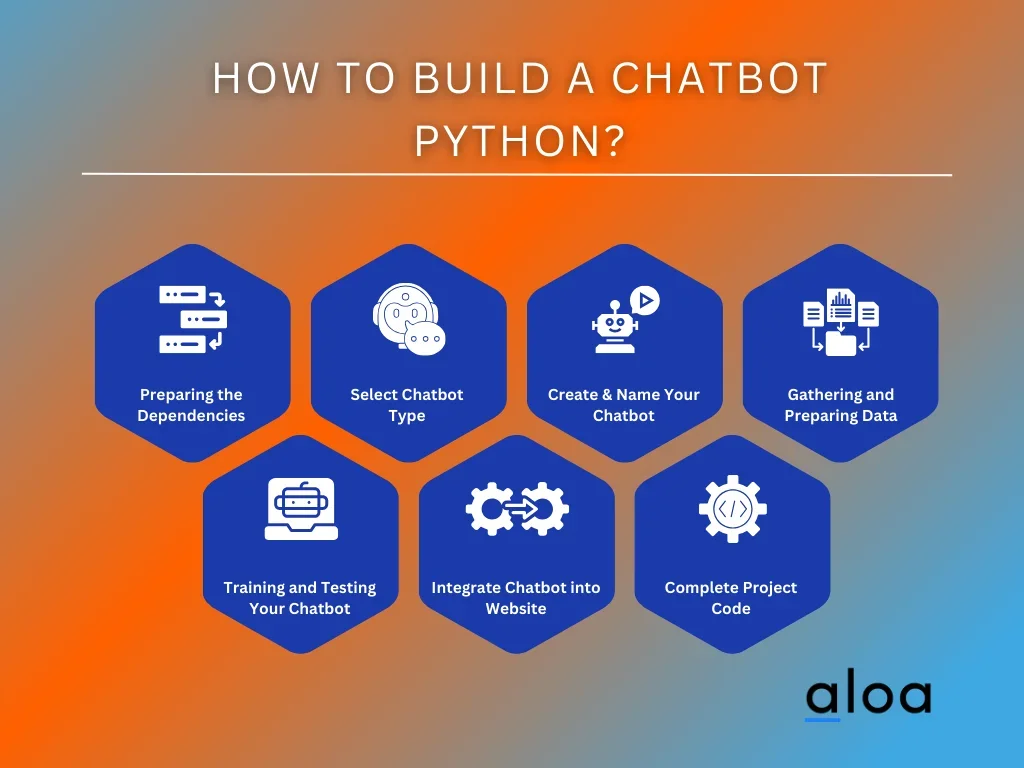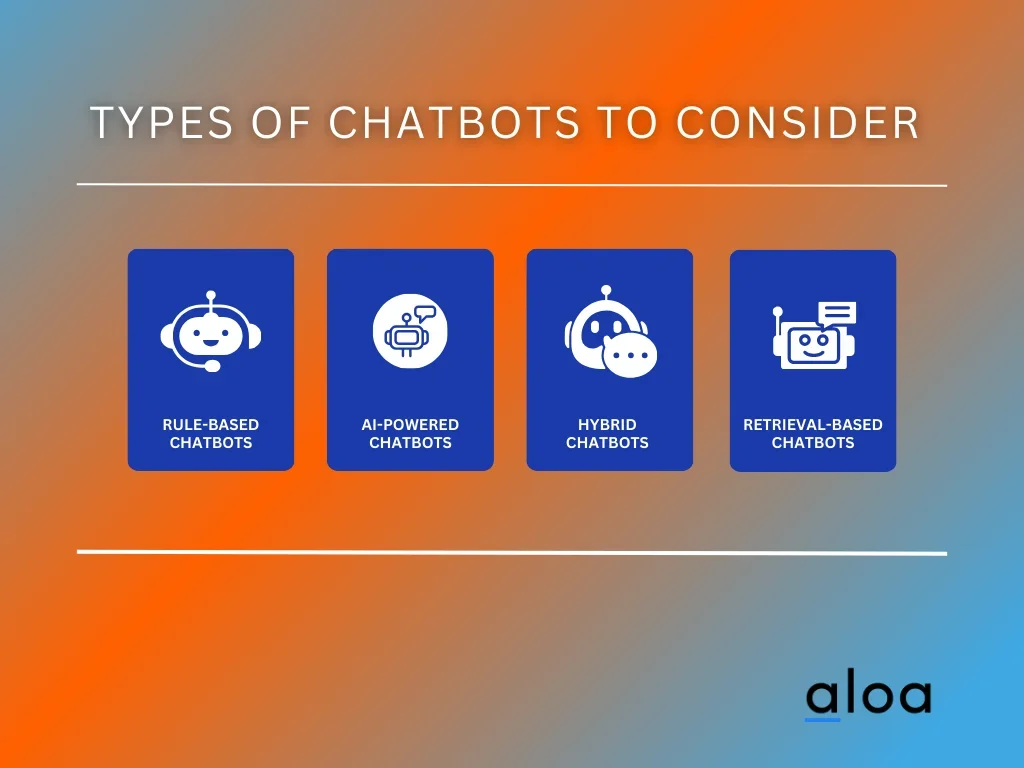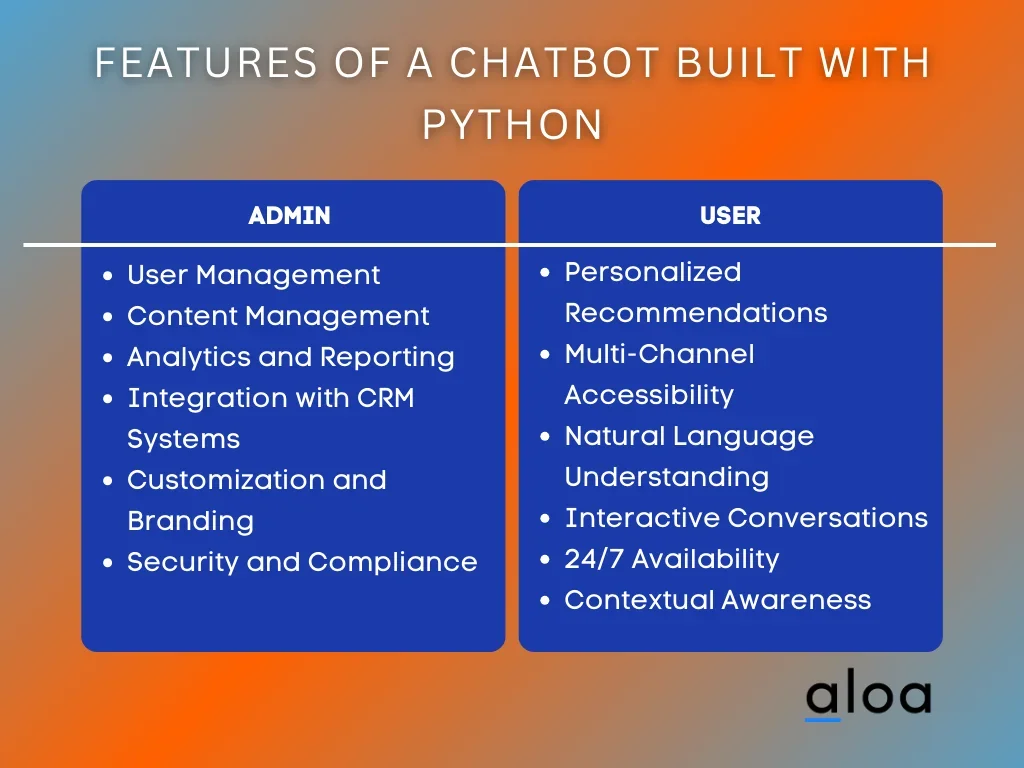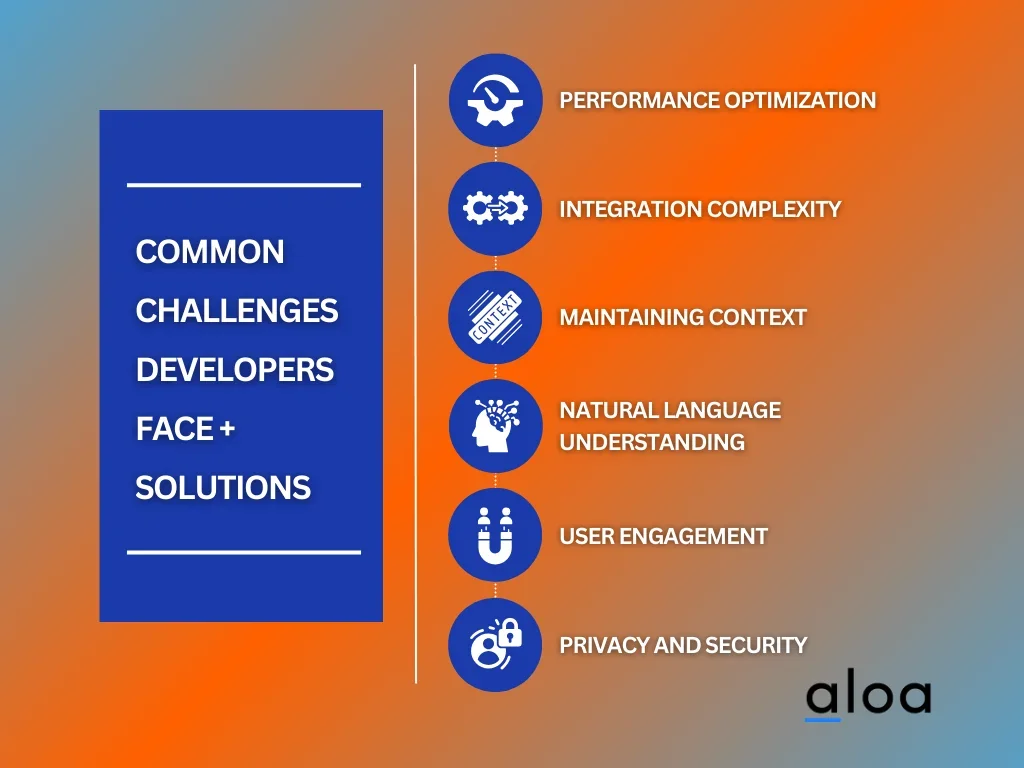Chatbot Python is a conversational agent built using the Python programming language, designed to interact with users through text or speech. These chatbots can be programmed to perform various tasks, from answering questions to providing customer support or even simulating human conversation.
However, leveraging Artificial Intelligence technology to create a sophisticated chatbot Python requires a solid understanding of natural language processing techniques and machine learning algorithms.
Aloa, an expert outsourcing firm, offers comprehensive solutions to navigate these challenges for software development and startups. Leveraging their expertise in chatbot Python development, Aloa provides innovative tools and services tailored to enhance customer interaction and streamline business operations for startups and established companies.
This blog will explore the steps of building your own chatbot, covering essential steps and considerations. By the end of this post, you will clearly understand how to leverage Python to create functional and practical chatbots to enhance various aspects of business operations.
Let’s dive in!
How to Build a Chatbot Python
Building a chatbot Python requires a deep understanding of natural language processing and machine learning algorithms to create intelligent conversational interfaces. Leveraging a correct chatterbot library and framework for effective development is also crucial. Here’s how to build a chatbot Python that engages users and enhances business operations.

Step 1: Preparing the Dependencies
Before delving into the development of a chatbot Python, the initial step is to meticulously prepare the essential dependencies, including hiring a ChatGPT developer. This involves installing requisite libraries and importing crucial modules to lay the foundation for the development process.
As a versatile programming language, Python offers extensive specialized libraries and frameworks designed explicitly for chatbot development, such as NLTK, the most popular Python library, spaCy, and Rasa.
These libraries, including the ChatterBot module, provide developers with many functionalities spanning natural language processing, machine learning, and conversational logic, empowering them to create robust and intelligent chatbot solutions for various computer program applications.
Furthermore, leveraging tools such as Pip, the Python package manager, facilitates the seamless installation of dependencies and efficient project requirements management. By ensuring all necessary dependencies are in place, developers can embark on subsequent stages to create a chatbot with confidence and clarity.
Step 2: Choose a Type of Chatbot to Develop
Selecting the appropriate type of chatbot Python is a critical decision that significantly influences its functionality, performance, and overall success in meeting your project goals and user requirements. Different types of chatbots offer unique advantages and capabilities, so it’s essential to carefully evaluate each option based on different factors.
Here are the types of chatbots to consider:

- Rule-based Chatbots: Basic chatbots, such as rule-based ones, operate on predefined rules and patterns to generate responses based on specific keywords or commands. They are ideal for handling simple interactions and can be easily implemented with minimal complexity.
- AI-powered Chatbots: These, including advanced ones like ChatGPT, utilize deep learning techniques and advanced machine learning algorithms to analyze and understand natural language input, enabling them to generate contextually relevant and personalized responses. AI chatbots excel in handling complex conversations and can continually enhance their performance through training data.
- Hybrid Chatbots: These chatbots combine elements of both rule-based and AI-powered approaches to capitalize on the strengths of each methodology. By blending predefined rules with machine learning capabilities, hybrid chatbots offer flexibility and adaptability while maintaining control over specific interactions.
- Retrieval-based Chatbots: These chatbots retrieve predefined responses from a database based on user input, making them suitable for handling structured inquiries. While they cannot generate novel responses, they provide accurate and consistent answers to frequently asked questions.
By carefully considering the type of chatbot Python to develop, you can align your project goals with the most suitable approach to achieve optimal results. Understanding the strengths and limitations of each type is also essential for building a chatbot that effectively meets your objectives and engages users.
Step 3: Creating and Naming Your Chatbot
Creating and naming your chatbot Python is an exciting step in the development process, as it gives your bot its unique identity and personality. Consider factors such as your target audience, the tone and style of communication you want your chatbot to adopt, and the overall user experience you aim to deliver.
A well-chosen name can enhance user engagement and make your chatbot more memorable and relatable. Avoid generic or overly technical names and opt for something catchy, memorable, and aligned with your brand personality. Additionally, consider how your chatbot’s name will be displayed and referenced across different platforms and channels where it will be deployed.
Consistency in naming helps reinforce your brand identity and ensures a seamless user experience. Once you’ve selected the perfect name for your chatbot, you’re ready to proceed with the subsequent development steps, confident in the unique identity and personality you’ve bestowed upon your creation.
Step 4: Gathering and Preparing Data
In developing a chatbot Python, thorough data gathering and preparation are essential to ensure its effectiveness. This includes utilizing insights from an Ask AI product review to inform decision-making and refine the chatbot’s capabilities. By carefully collecting and preprocessing relevant datasets, developers lay the groundwork for the chatbot to understand user inquiries and generate accurate responses.
Here are how to gather and prepare data:
- Collect Relevant Datasets: Methodically gather data from diverse sources including FAQs, support transcripts, and conversational datasets. Ensure alignment with your chatbot's scope and user queries for comprehensive data acquisition, covering a wide range of topics and scenarios.
- Label and Annotate Data: Implement a meticulous organization system, labeling, and annotating collected data into distinct categories or topics. This structured approach facilitates the chatbot's training process, enabling it to effectively recognize and respond to a diverse array of user inquiries with precision and relevance.
- Clean and Preprocess Data: Conduct thorough data refinement procedures to enhance dataset quality. This involves removing extraneous noise, addressing formatting inconsistencies, and eliminating duplicate entries. By meticulously preprocessing the data, the chatbot's response accuracy and efficiency are significantly improved, ensuring seamless interactions with users.
- Augment Data If Necessary: Strategically augment the dataset size by integrating synthetic data using advanced techniques such as data augmentation or leveraging pre-trained language models. This augmentation enriches the breadth and depth of the training examples, empowering the chatbot to enhance its performance and adaptability, particularly in scenarios with limited original data.
By following the best data collection, labeling, preprocessing, and augmentation practices, you can ensure that your chatbot is equipped with the necessary information to provide accurate and relevant responses, enhancing the overall user experience.
Step 5: Training and Testing Your Chatbot
Training and testing your chatbot Python is a pivotal phase in the development process, where you fine-tune its capabilities and ensure its effectiveness in real-world scenarios. Begin by training your chatbot using the gathered datasets, employing supervised learning or reinforcement learning techniques to optimize its conversational skills.
Once trained, it’s essential to thoroughly test your chatbot across various scenarios and user inputs to identify any weaknesses or areas for improvement. During testing, simulate diverse user interactions to evaluate the chatbot’s responses and gauge its performance metrics, such as accuracy, response time, and user satisfaction.
By rigorously training and testing your chatbot, you ensure that it meets the desired performance standards and delivers a seamless conversational experience for users across various platforms and communication channels.
Step 6: Integrating Your Chatbot into Your Web
Integrating your chatbot Python into your website is a crucial step that enables seamless user interaction and enhances the overall user experience. Visitors to your website can access assistance and information conveniently, fostering engagement and satisfaction.
Here are the key points to consider:
- Choose the Proper Integration Method: Determine whether you’ll integrate your chatbot using a pre-built plugin, custom API integration, or a platform with built-in web integration capabilities.
- Design a User-friendly Interface: Create a visually appealing and intuitive interface for your chatbot that seamlessly blends with your website’s design and enhances the overall user experience.
- Ensure Cross-browser Compatibility: Test your chatbot across different web browsers and devices to ensure consistent user performance and functionality.
- Implement Proactive Engagement: Consider implementing proactive engagement features such as chat triggers or pop-up messages to initiate conversations with website visitors and enhance user engagement.
Integrating your chatbot into your website is essential for providing users convenient access to assistance and information while enhancing overall user engagement and satisfaction. By considering key integration points and ensuring a seamless user experience, you can effectively leverage your chatbot to drive meaningful interactions and achieve your website’s objectives.
Step 7: Complete Project Code
Completing the project code is the last stage in your journey of building a chatbot Python, where meticulous organization, comprehensive documentation, and rigorous testing converge to ensure a robust and functional application. This phase involves packaging your code into a deployable format and implementing essential security measures to safeguard sensitive user data and comply with privacy regulations.
With continuous monitoring and iterative improvements post-deployment, you can optimize your chatbot’s performance and enhance its user experience. By focusing on these crucial aspects, you bring your chatbot Python project to fruition, ready to deliver valuable assistance and engagement to users in diverse real-world scenarios.
Features of a Chatbot Built with Python
Exploring the capabilities and functionalities of chatbot Python provides valuable insights into their versatility and effectiveness in various applications. Here are the key features and attributes that make chatbot Python stand out in delivering seamless and engaging user experiences, showcasing its ability to perform various functions effectively.

Admin Side Features of a Chatbot Python
Chatbot Python offers various features that enhance its functionality and usability. Here are the admin-side functionalities that facilitate seamless management and optimization of chatbots:
- User Management: This feature enables administrators to create, edit, or delete user profiles and control access levels, ensuring secure user management within the chatbot system.
- Content Management: Administrators can easily update responses, FAQs, and other content elements to ensure accurate and up-to-date information is provided to users, enhancing their overall experience.
- Analytics and Reporting: Administrators gain valuable insights into chatbot usage, user engagement, and conversation completion rates, facilitating data-driven decisions to optimize the chatbot’s effectiveness.
- Integration with CRM Systems: Seamless integration with CRM systems enables synchronization of chatbot interactions with customer data, enhancing personalized user experiences and providing comprehensive customer insights.
- Customization and Branding: Administrators can configure colors, logos, greetings, and language styles to create a unique brand identity, reinforcing brand recognition and engaging users effectively.
- Security and Compliance: Robust security features, including authentication mechanisms, encryption protocols, and access controls, protect user data and ensure compliance with privacy regulations, fostering trust among users.
User Side Features of a Chatbot Python
Aside from admin-side features, chatbot Python also offers a range of functionalities for users. Here are the features designed to enhance the user experience and streamline interaction:
- Personalized Recommendations: Users receive tailored suggestions and recommendations based on their preferences and previous interactions, enhancing their experience and satisfaction.
- Multi-Channel Accessibility: Users can interact with the chatbot seamlessly across various channels, including websites, mobile apps, and messaging platforms, ensuring convenient access to assistance and information.
- Natural Language Understanding: The chatbot accurately interprets user inputs, including nuances in human speech, and responds in natural language, providing a conversational and intuitive user experience.
- Interactive Conversations: Users engage in interactive conversations with the chatbot, which utilizes regular expressions to understand user input, enabling them to ask questions, provide feedback, and receive real-time responses, fostering engagement and interaction.
- 24/7 Availability: The chatbot Python is available round-the-clock, allowing users to access assistance and information anytime, enhancing accessibility and convenience.
- Contextual Awareness: The chatbot maintains context throughout conversations, understanding nuances in human language and remembering previous interactions to provide relevant responses, improving user satisfaction and efficiency.
Common Challenges Developers Face + Solutions
Navigating the landscape of chatbot Python development presents numerous challenges that developers must overcome for successful implementation. Here are the challenges developers often encounter and practical solutions to ensure smooth progression in their chatbot projects.

Performance Optimization
Optimizing chatbot Python performance to handle high volumes of concurrent users while maintaining responsiveness can be daunting. Solutions involve leveraging scalable cloud infrastructure, optimizing algorithms for efficiency, and implementing caching mechanisms using the library ChatterBot to reduce response times.
Additionally, developers can employ load balancing and horizontal scaling to distribute workload effectively and ensure consistent performance under heavy traffic conditions.
Integration Complexity
Integrating chatbot Python seamlessly into existing systems and platforms can be complex, requiring compatibility with various technologies and APIs. Solutions involve:
- Hiring a ChatGPT developer who works closely with the IT team
- Using flexible integration frameworks
- Standardizing communication protocols to ensure smooth integration.
Furthermore, developers can leverage tools and platforms that offer pre-built integrations with popular systems and services, reducing development time and complexity.
Maintaining Context
Maintaining context throughout a conversation poses a challenge, as chatbots must remember previous interactions to provide meaningful responses. Solutions involve:
- Implementing content management systems.
- Utilizing memory networks.
- Employing state management techniques to track conversation history effectively.
Additionally, developers can leverage conversational AI techniques such as dialogue management to maintain context and coherence in multi-turn conversations, ensuring a seamless user experience.
Natural Language Understanding
One of the primary challenges developers face is training chatbot Python to accurately interpret and respond to user inputs, especially in handling nuances, colloquialisms, and context. Solutions involve:
- Leveraging pre-trained language models.
- Implementing NLP algorithms from the Natural Language Toolkit.
- Continually refining training data through user feedback loops.
Additionally, developers can employ techniques such as intent classification and entity recognition to enhance the chatbot’s understanding of user queries and improve response accuracy across natural human languages.
User Engagement
Sustaining user engagement over extended interactions is challenging, especially in customer service, as users may lose interest or become frustrated with repetitive responses. Solutions include:
- Incorporating diverse conversational flows.
- Introducing personalized recommendations.
- Implementing interactive elements keeps users engaged and enhances the overall customer service experience.
Developers can leverage techniques such as reinforcement learning to adapt the chatbot’s conversational style based on user feedback and preferences, enhancing user engagement and retention.
Privacy and Security
Ensuring the privacy and security of user data within chatbot interactions is paramount. Still, it can be challenging due to regulatory requirements and potential vulnerabilities. Solutions include:
- Implementing end-to-end encryption.
- Adhering to data protection standards.
- Regularly auditing chatbot systems for security vulnerabilities.
Furthermore, developers can integrate user authentication mechanisms, access controls, and data anonymization techniques to protect sensitive information and mitigate the risk of data breaches or unauthorized access.
Key Takeaway
Building a chatbot Python offers many possibilities for businesses and developers alike, enabling seamless user interactions, streamlined processes, and enhanced customer satisfaction. By leveraging chatbot Python’s robust functionalities, organizations can elevate their digital presence and deliver personalized experiences to their users, enhancing their data science and analytics capabilities.
Embracing the power of Python in chatbot development opens doors to innovative solutions and transformative experiences, paving the way for continued growth and success in the dynamic landscape of conversational AI.
To learn more, sign up to our email list at Aloa’s blog page today to discover more insights, tips, and resources on software development, outsourcing, and emerging technologies. Explore our latest articles and stay updated on industry trends to drive your business forward with Aloa’s expertise and insights.

